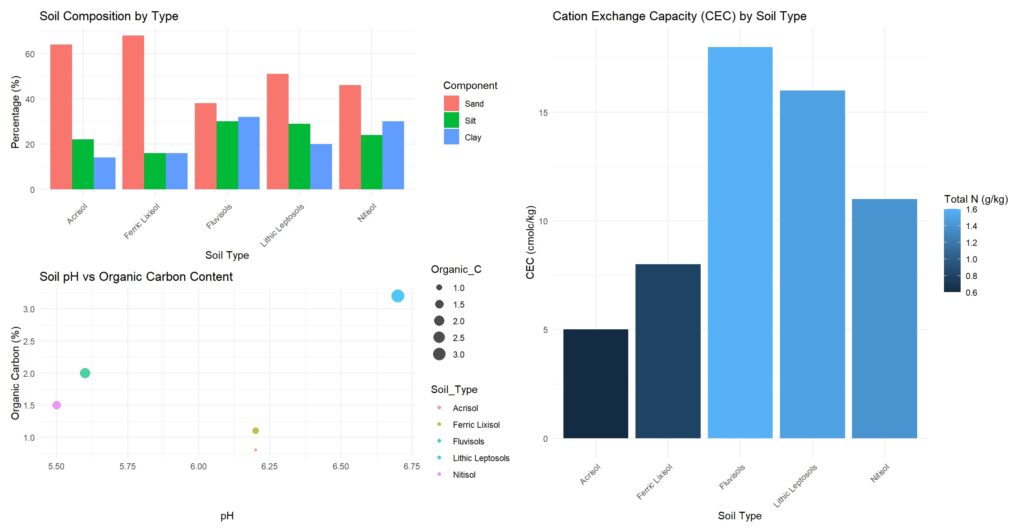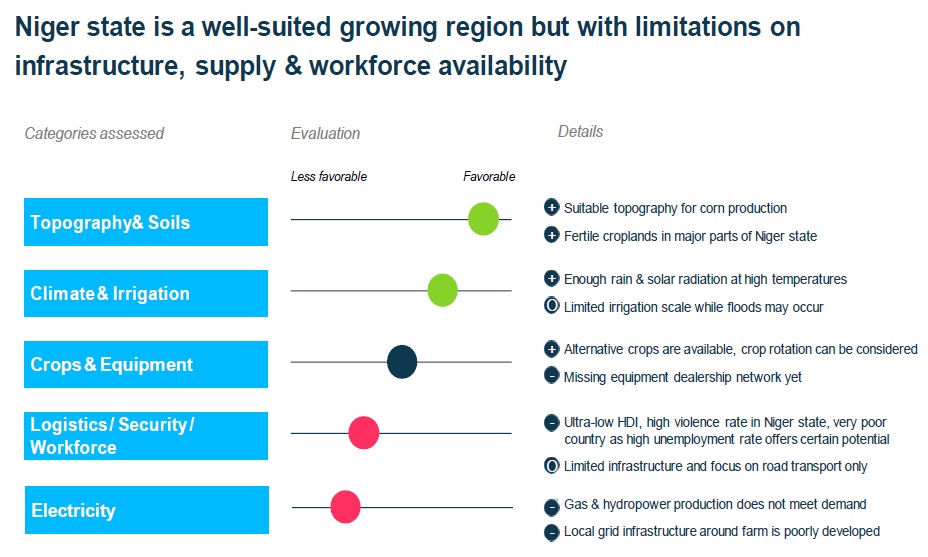Soil Fertility and Crop Suitability Facts


The soil types in Niger State exhibit diverse characteristics that significantly influence their suitability for cattle breeding, fattening, and agricultural crop production.
Ferric Lixisols and Nitisols are moderately well-drained soils with a substantial rootable depth (>100 cm), making them highly suitable for both crop cultivation and pasture establishment. Their sandy loam and sandy clay loam textures provide an optimal balance between water retention and drainage, supporting the growth of forage crops such as alfalfa, sorghum, and maize. Additionally, these soils exhibit moderate organic carbon levels (1.1–1.5%) and pH values (5.5–6.2), which enhance nutrient availability for both crops and pasture grasses.
Fluvisols, characterized by a clay loam texture and high clay content (32%), have imperfect drainage but exhibit high organic carbon (2.0%) and a cation exchange capacity (CEC) of 18 cmolc/kg. These properties make Fluvisols highly fertile and well-suited for water-demanding crops such as rice, sugarcane, and legumes like cowpea, which serve as high-protein feed for cattle.
Acrisols, though poorly drained, feature a sandy loam texture and a moderate pH (6.2), which can support drought-resistant crops such as millet and groundnut. However, their relatively low organic carbon (0.8%) and CEC (5 cmolc/kg) limit fertility, necessitating soil amendments to optimize productivity.
Lithic Leptosols, with a shallow depth (<10 cm) and loamy texture, are less suited for intensive agriculture but support extensive pasture systems for cattle grazing. Their high organic carbon content (3.2%) and neutral pH (6.7) provide a conducive environment for resilient grasses such as Bermuda grass and Guinea grass, which are excellent forage options for livestock.
The soil characteristics of Niger State present both opportunities and challenges for cattle breeding and fattening, as well as for feed crop production within intensive and extensive livestock management systems.
Ferric Lixisols and Nitisols are particularly suited for intensive feedlot systems due to their favorable drainage and fertility. These soils support the cultivation of high-yield forage crops, including sorghum, maize, and alfalfa, which are essential for cattle fattening. Their moderate CEC (8–11 cmolc/kg) ensures effective nutrient retention, reducing dependence on synthetic fertilizers.
Fluvisols, with their high clay content and natural fertility, are ideal for rice paddies and legume cultivation, providing supplementary feed sources for cattle. However, proper water management strategies are necessary to mitigate the risk of waterlogging, which could adversely impact both crop productivity and pasture quality.
Acrisols present limitations due to poor drainage and low fertility, but strategic soil amendments—such as the application of lime and organic manure—can improve their productivity. These soils are better suited for extensive grazing systems than for intensive feedlot agriculture. Drought-resistant crops like millet and groundnut can be successfully cultivated to supplement livestock feed.
Lithic Leptosols, despite their shallow depth, are valuable for extensive grazing systems, particularly due to their high organic carbon content and neutral pH. Hardy grasses such as Bermuda grass and Guinea grass flourish in these soils, providing a year-round forage supply for cattle. However, their restricted root penetration capacity limits their use for crop cultivation. Source: -https://www.fao.org/soils-portal/data-hub/soil-maps-and-databases/soil-profile-databases/en/

The soil types in Niger State offer significant potential for integrated crop-livestock systems, which can enhance cattle breeding and fattening while improving soil fertility through sustainable land-use practices.
Feedlot Systems
Ferric Lixisols and Nitisols are optimal for feedlot development due to their good drainage and fertility. High-energy forage crops such as sorghum, maize, and alfalfa can be cultivated to sustain cattle growth and fattening. Additionally, integrating legumes like cowpea can enhance soil nitrogen levels, reducing the reliance on synthetic fertilizers.
Extensive Pasture Systems
Lithic Leptosols and Acrisols are well-suited for extensive grazing systems. The cultivation of resilient pasture grasses like Bermuda grass and Guinea grass supports sustainable livestock production, particularly for smallholder farmers who rely on low-input systems.
Soil Fertility Management
Applying organic manure and incorporating crop residues from forage cultivation can significantly improve soil fertility, particularly in Acrisols and Ferric Lixisols. Furthermore, sustainable practices such as rotational grazing and intercropping can enhance soil health, reducing nutrient depletion over time.
Climate Resilience
The promotion of drought-tolerant crops, such as millet and sorghum, in Acrisols and Lithic Leptosols ensures feed availability during dry seasons. This resilience is particularly crucial for cattle fattening, where consistent feed supply is essential for optimal weight gain.
By leveraging the unique properties of these soils, Niger State can establish a robust and sustainable livestock production system that integrates intensive feedlots and extensive grazing, ensuring long-term productivity and food security.